RESEARCH
Iodine status in late pregnancy and psychosocial determinants of iodized salt use in rural northern Viet Nam
Statut iodé en fin de grossesse et déterminants psychosociaux de l'utilisation de sel iodé dans les régions rurales du nord du Viet Nam
Niveles de yodo durante los últimos meses del embarazo y determinantes psicosociales del uso de sal yodada en las zonas rurales del Norte de Viet Nam
Jane FisherI, *; Thach TranI; Beverley BiggsII; Tuan TranIII; Terry DwyerIV; Gerard CaseyII; Dang Hai ThoIII; Basil HetzeV
ISchool of Public Health and Preventive Medicine, Monash University, Clayton, Australia 3168
IIThe University of Melbourne, The Royal Melbourne Hospital, Melbourne, Australia
IIIResearch and Training Centre for Community Development, Hanoi, Viet Nam
IVMurdoch Childrens Research Institute, Royal Children's Hospital, Victoria, Australia
VInternational Council for Control of Iodine Deficiency Disorders, Women's and Children's Hospital, Adelaide, Australia
ABSTRACT
OBJECTIVE: To establish iodine status among pregnant women in rural northern Viet Nam and explore psychosocial predictors of the use of iodized salt in their households.
METHODS: This prospective study included pregnant women registered in health stations in randomly-selected communes in Ha Nam province. At recruitment (< 20 weeks of gestation), sociodemographic factors, reproductive health, intimate partner relationship, family violence, symptoms of common mental disorders and use of micronutrient supplements were assessed. During a second assessment (> 28 weeks of gestation) a urine specimen was collected to measure urinary iodine concentration (UIC) and iodized salt use was assessed. Predictors were explored through univariable analyses and multivariable linear and logistic regression.
FINDINGS: The 413 pregnant women who provided data for this study had a median UIC of 70 μg/l; nearly 83% had a UIC lower than the 150 μg/l recommended by the World Health Organization; only 73.6% reported using iodized salt in any form in their households. Iodized salt use was lower among nulliparous women (odds ratio, OR: 0.56; 95% confidence interval, CI: 0.32-0.96); less educated women (OR: 0.34; 95% CI: 0.16-0.71); factory workers or small-scale traders (OR: 0.52; 95% CI: 0.31-0.86), government workers (OR: 0.35; 95% CI: 0.13-0.89) and women with common mental disorders at recruitment (OR: 0.61; 95% CI: 0.38-0.98).
CONCLUSION: The decline in the use of iodized salt in Viet Nam since the National Iodine Deficiency Disorders Control Programme was suspended in 2005 has placed pregnant women and their infants in rural areas at risk of iodine deficiency disorders.
RÉSUMÉ
OBJECTIF: Établir le statut iodé chez les femmes enceintes dans les régions rurales du nord du Viet Nam et étudier les prédicteurs psychosociaux de l'utilisation de sel iodé dans leur foyer.
MÉTHODES: Cette étude prospective a fait appel à des femmes enceintes enregistrées auprès de postes sanitaires dans des communes sélectionnées de manière aléatoire dans la province d'Ha Nam. Lors du recrutement (à moins de 20 semaines de gestation), on a évalué les facteurs sociodémographiques, la santé génésique, la relation intime avec le partenaire, la violence domestique, les symptômes de troubles mentaux communs et le recours aux apports en micronutriments. Lors d'une seconde évaluation (à plus de 28 semaines de gestation), des échantillons d'urine ont été recueillis afin d'en mesurer la concentration d'iode urinaire (CIU) et on a évalué l'utilisation de sel iodé. Les prédicteurs ont été étudiés par le biais d'analyses univariées et d'une régression logistique et linéaire multivariable.
RÉSULTATS: Les 413 femmes enceintes ayant fourni les données de cette étude présentaient une CIU médiane de 70 μ g/l, pour près de 83% d'entre elles, la CIU était inférieure aux 150 μ g/l recommandés par l'Organisation mondiale de la Santé et seules 73,6% d'entre elles ont indiqué utiliser du sel iodé sous quelque forme que ce soit dans leur foyer. L'utilisation du sel iodé était inférieure chez les femmes nullipares (rapport des cotes, RC: 0,56; intervalle de confiance de 95%, IC: 0,32-0,96), chez les femmes moins éduquées (RC: 0,34; IC de 95%: 0,16-0,71), chez les ouvrières en usine ou les petites commerçantes (RC: 0,52; IC de 95%: 0,31-0,86), chez les fonctionnaires (RC: 0,35; IC de 95%: 0,13-0,89) et chez les femmes présentant des troubles mentaux communs lors du recrutement (RC: 0,61; IC de 95%: 0,38-0,98).
CONCLUSION: La baisse de l'utilisation de sel iodé au Viet Nam depuis la suspension en 2005 du programme national de lutte contre les troubles dus à la carence en iode fait courir des risques de troubles liés à la carence en iode aux femmes enceintes et à leurs nouveau-nés.
RESUMEN
OBJETIVO Establecer los niveles de yodo entre las mujeres embarazadas del Norte de Viet Nam y examinar los indicadores psicosociales del uso de sal yodada en sus hogares.
MÉTODOS: Este estudio prospectivo incluyó a mujeres embarazadas registradas en los puestos de salud de diversos municipios elegidos de forma aleatoria en la provincia de Ha Nam, Viet Nam. Durante la selección (<20 semanas de gestación), se evaluaron factores sociodemográficos, salud reproductiva, relación íntima con la pareja, violencia familiar, síntomas de trastornos mentales comunes y el uso de suplementos de micronutrientes. Durante una segunda evaluación (>28 semanas de gestación), se recogió una muestra de orina para medir la concentración de yodo urinario (CYU) y se evaluó el uso de sal yodada. Se examinaron los indicadores mediante análisis monofactorial y una regresión lineal multifactorial y logística.
RESULTADOS: Las 413 mujeres embarazadas que proporcionaron datos para este estudio presentaron una CYU media de 70 μ g/l; casi el 83% presentaba una CYU inferior a 150 μ g/l (el nivel recomendado por la Organización Mundial de la Salud); solo el 73,6% informó de que utilizaba sal yodada en su hogar, en cualquiera de sus formas. El uso de sal yodada fue inferior entre mujeres nulíparas (cociente de probabilidades, CP: 0,56; intervalo de confianza del 95%, IC: 0,32-0,96); mujeres con un menor nivel educativo (CP: 0,34; IC del 95%: 0,16-0,71); trabajadoras de fábrica o comerciantes a pequeña escala (CP: 0,52; IC del 95%: 0,31-0,86), funcionarias (CP: 0,35; IC del 95%: 0,13-0,89) y mujeres con trastornos mentales comunes durante la selección (CP: 0,61; IC del 95%: 0.38-0.98).
CONCLUSIÓN La reducción del uso de sal yodada en Viet Nam desde que en 2005 se suspendió el Programa de Control de Trastornos de Deficiencia de Yodo, ha puesto a las mujeres embarazadas que residen en áreas rurales, así como a sus hijos, en riesgo de sufrir trastornos por deficiencia de yodo.

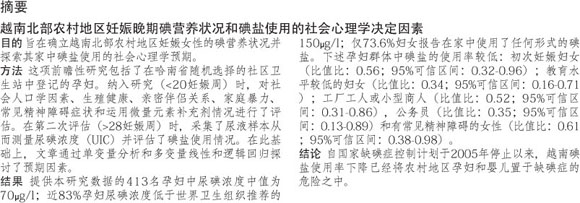
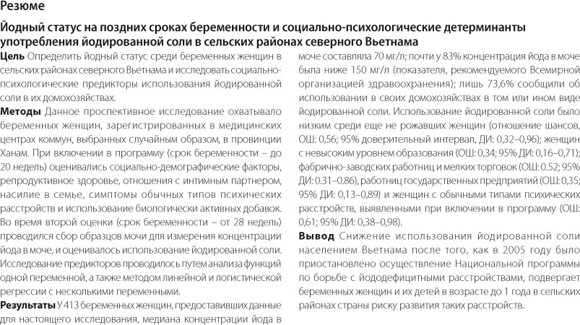
Introduction
Iodine is an essential micronutrient and a constituent of the thyroid hormones thyroxine (T4) and triiodothyronine (T3). Iodine deficiency in pregnant women limits fetal brain growth and, when severe, can lead to cretinism and the pervasive intellectual, psychomotor and sensory disabilities and congenital anomalies that accompany it.1,2 Prenatal iodine deficiency can cause maternal goiter and hypothyroidism. Iodine deficiency disorders (IDDs) in pregnant women carry a risk of spontaneous abortion, stillbirth, perinatal death and stunted infant growth. Iodine requirements are higher during pregnancy because of greater maternal need for thyroid hormones, transfer of thyroid hormones and iodine from mother to fetus, and a probable increase in maternal renal iodine clearance.1,3-5
The International Council for the Control of Iodine Deficiency Disorders (ICCIDD) recommends universal salt iodization as the most effective strategy for eliminating IDD globally. In 1994 the prime minister of Viet Nam issued Decision 481, which urged the whole population to buy and use iodized salt.6 In 1999, the Government's Decree 19 on the production and supply of iodized salt for human consumption stipulated that all salt for human consumption had to be iodized.7 Between 1995 and 2005 the Government, with support from the United Nations Children's Fund (UNICEF) and the ICCIDD, implemented the National IDD Control (NIDDC) programme and established a well organized and efficient system to prevent and monitor IDDs in the country. Under this programme, KIO3 (Kali iodate) was provided to salt producers and the retail costs of producing iodized salt were subsidized. With these strategies, Viet Nam made remarkable progress in reducing IDDs in 1995 to 2005. The proportion of households using iodized salt increased from 25% in 1993 to 94% in 2005 and the national median urinary iodine concentration (UIC) increased from 32 μ g/l to122 μ g/l.8 However, in 2005 the Government declared that iodine deficiency in Viet Nam had been eliminated and promptly replaced Decree 19 with Decree 163, which removed the requirement that all salt for human consumption be iodized.9 The NIDDC programme was terminated and the budget for IDD control activities was reallocated.10
The World Health Organization (WHO), UNICEF and the ICCIDD have reiterated that strategies to sustain iodized salt use are essential to prevent the recurrence of IDDs in Viet Nam.11 In 2008, the National Survey of Iodine Deficiency Disorders reported a marked decline in household iodized salt coverage to 70% nationally and less than 30% in urban areas, including Hanoi and Ho Chi Minh cities.10 Evidence of a drop in median UIC emerged.10,12
Currently, antenatal health promotion strategies recommend the use of iodized salt during pregnancy in Viet Nam. However, because iodized salt is no longer a subsidized commodity and costs more than ordinary salt, its purchase is particularly burdensome for the poorest families. Recently "cooking powders", which contain salt (iodized or non-iodized), monosodium glutamate (MSG) and other seasonings, have become popular in everyday cooking as substitutes for traditional salt. In a previous study in this setting, we found that women suffering from common perinatal mental disorders or who were experiencing emotional abuse from family members in a multigenerational household were less likely to be taking recommended micronutrient supplements.13 We speculated that these experiences could undermine autonomy in financial decision-making, including the decision to purchase iodized salt. However, the factors that govern the use of iodized salt among pregnant women living in Viet Nam's rural areas remain unknown.
The objectives of this study, which was conducted five years after the NI-DDC programme was suspended in 2005, were to investigate iodine status among women in advanced pregnancy in rural northern Viet Nam by measuring UIC and to explore the psychosocial predictors of the use of iodized salt in their households.
Methods
This study was part of a prospective investigation of a cohort of women in rural northern Viet Nam who were recruited and first assessed when they were less than 20 weeks pregnant and followed up, along with their infants, to determine the potential effects of perinatal micronutrient deficiencies and common maternal mental disorders, separately or in combination, on infant health and development.
Study setting
This study was conducted in Ha Nam, a typical Red River delta rural province located 50 km south of Hanoi. Ha Nam province has 0.8 million inhabitants, most of whom live in lowland flood-prone rural delta areas and rely on subsistence agriculture, mainly rice farming. In 2010 the average annual per capita income was 800 United States dollars (US$) and about 7.5% of the people lived on less than US$ 1 a day, the international poverty threshold.14
Sampling and recruitment
A two-stage sampling procedure was used. First, an independent statistician selected 50 communes randomly from the list of 116 communes in the province. Second, all women registered with the commune health station as being 12 to 20 weeks pregnant were eligible and invited to participate in the baseline survey, which was conducted in the selected communes from December 2009 to January 2010 (Wave One, W1). The second survey (Wave 2, W2) was carried out between March and June 2010, when participants were at least 28 weeks pregnant.
Data sources
Psychosocial and biological data were collected from each participant. Study-specific structured interviews for each wave were developed based on our prior research and existing evidence.15,16 Most items were in fixed-choice format. The instruments were translated from English into Vietnamese, reviewed by a group of clinicians and researchers for meaning, comprehensibility and cultural appropriateness, and back-translated into English for verification.17
Sociodemographic factors (W1)
Sociodemographic characteristics included age and marital, educational and occupational status. Information about 17 household characteristics, services and durable assets was collected to calculate a household wealth index by the World Bank method.18 Current coincidental life adversity was assessed through an open-ended question.
Reproductive health (W1)
Relevant aspects of reproductive health included gravidity, parity, history of spontaneous abortions and of fetal or neonatal deaths and general appraisal of antenatal health.
Food security (W1 and W2)
Household food security was measured by the Household Food Insecurity Access Scale,19 which includes nine questions on the degree of anxiety and uncertainty about the household food supply, food quality and the sufficiency of food intake in the past four weeks.
Health care use (W1 and W2)
Participation in preventive health care was assessed by means of fixed-choice and open-ended questions about the consumption of iodized or non-iodized salt, cooking powder or iron supplements during the index pregnancy and the reasons behind their use or non-use. Antenatal care was assessed in terms of the number and location of health checks and the health professionals who provided care.
Quality of family relationships (W1)
Many women in the study setting live in multigenerational households and the quality of a woman's intimate relationships with her partner, her own mother and her mother-in-law is a determinant of perinatal mental health and of access to financial resources. The presence or absence of intimate partner violence was assessed using the pregnancy section of the WHO Multicountry Study on Domestic Violence survey,20 which assesses physical and sexual violence, emotional abuse and controlling behaviour.
Common mental disorders (W1)
Symptoms of the common mental disorders of depression and anxiety were assessed by the Edinburgh Postnatal Depression Scale - Viet Nam Validation (EPDS-V).21,22 The EPDS is a widely used 10-item screening tool for current symptoms. Each item is scored from 0 to 3 and all scores are added to yield a total from 0 to 30. We have validated the tool in the study setting and have established that a cut-off total score of 4/5 has optimal sensitivity and specificity for identifying clinically important symptoms.22
Urinary iodine (W2)
A casual urine sample of approximately 10 ml was obtained in W2 from each participant willing to provide one.
Procedure
The Vietnamese are unfamiliar with self-reported questionnaires. Hence, psychosocial data were collected during individual interviews and recorded on paper forms. Urine samples were frozen in a field freezer and transported in a cold chain to the laboratory of the National Hospital of Endocrinology in Hanoi, which conducts UIC analyses for national surveys in Viet Nam. At the laboratory, UIC was determined by means of the Sandell-Kolthoff reaction, as recommended by WHO, UNICEF and the ICCIDD.23 All data were entered into password-protected files at the Research and Training Centre for Community Development in Hanoi.
Data management and analysis
Statistical analyses were conducted in Stata version 11 (StataCorp. LP, College Station, United States of America). Summary scores for the psychometric measures were calculated where indicated. Household food insecurity was classified in terms of feeling anxiety or uncertainty about the household's food supply, inadequate food quality or insufficient food intake. Because UIC was not normally distributed in this community sample, it was summarized by distribution curve and median value, with 95% confidence interval. WHO/ UNICEF/ICCIDD guidelines24 were used to classify iodine nutritional status as adequate (UIC > 150 μ g/l) or deficient (UIC < 150 μ g/l). We did not apply the epidemiological criteria for assessing the severity of iodine deficiency provided in the guidelines because these have been calculated for the general population, not specifically for pregnant women, whose iodine requirements are higher than those of other adults. A participant was classified as a user of iodized salt if she reported using either conventional iodized salt or iodized cooking powder.
Multivariable linear and logistic regression analyses were conducted to ascertain the psychosocial correlates of iodine status and the psychosocial predictors of the use of iodized salt. Natural log transformation of UIC was used in those analyses because the UIC distribution was skewed.
Ethics approval
The Ha Nam Provincial Health Department Ethics Committee, the Viet Nam Medical Association Ethics and Scientific Committee and the University of Melbourne's Human Research Ethics Committee approved the study.
Results
Sample
In total, 497/523 (97%) pregnant women agreed to participate in the study and 413 women (83%) provided data at W2. Of the women not providing data at W2, 47 had already given birth, 15 were absent when the data collection team visited the commune, 7 had a late miscarriage or stillbirth and 15 had withdrawn. Only data from the 413 women who were assessed at W1 and W2 were included in the analyses.
The sociodemographic characteristics of the sample are summarized in Table 1. The sample reflects the characteristics of the population of Ha Nam province in terms of education, occupation and proportion of parents who have at least a third child. In this study, the rates of common mental disorders among pregnant women; of exposure to intimate partner violence; of fear of other family members and of concern over household food insecurity are similar to the rates detected in our former research in this setting.13 Food insecurity, poverty, violence and poor mental health status were inter-related: 56% of the participants in the lowest wealth quintile reported food insecurity compared with 16.3% of those in the highest quintile (P < 0.0001); mental disorders were more common in women in the lowest quintile than in those in the highest quintile, and they were also more common in those who had experienced intimate partner violence in the past 12 months (P < 0.001).

Urinary iodine concentration
A right-skewed distribution of UIC was observed (Fig. 1). Most participants (82.6%) had a UIC lower than WHO's recommended level for adequate iodization (150 μ g/l) and the median UIC was 70 μ g/l (95% confidence interval, CI: 61-76), or approximately half of the recommended level (Table 2).
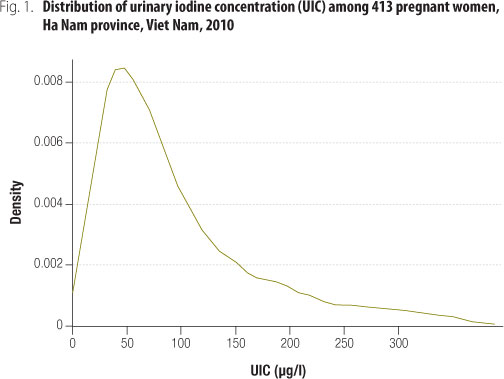
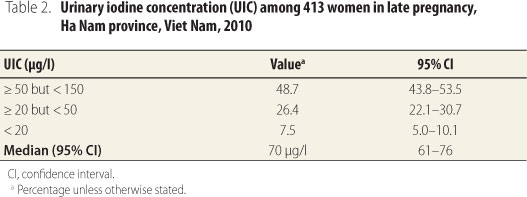
Correlates of urinary iodine concentration
No variables were associated with UIC in multiple linear regression analysis of the log transfer of UIC or in multivariable logistic regression analysis of iodine deficiency.
Prevalence and predictors of iodized salt use
In total, 73.6% (95% CI: 69.3-77.9) of participants reported the use of some form of iodized salt in their households. Equal numbers of households were using traditional iodized salt and iodized cooking powders and one fourth of the pregnant women surveyed were not using either product (Table 3).
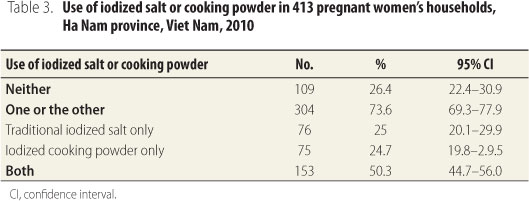
In multivariable logistic regression only parity, educational and occupational status and the presence of a common mental disorder in early pregnancy were associated with the use of iodized salt in advanced pregnancy (Table 4). With level of education and mental health status being equal, women farmers and housewives were more likely to be using iodized salt in cooking than women in non-agricultural occupations.
Women cited several reasons for not using iodized salt in response to open-ended questions. One was that they were familiar with a non-iodized product and saw no reason to change. Another was that they preferred using newly available herbal seasonings that were being promoted locally and contained no salt. A third reason given was that iodized salt made food taste bitter. In addition, many people in rural areas felt that food is "smoother" when prepared with cooking powder or MSG than when prepared with salt. A fourth reason was that iodized salt was not locally available for purchase. Finally, many women reported not using iodized salt because they did not know that it was important or necessary to use it during pregnancy.
Discussion
The findings indicate that iodine deficiency has recurred in Viet Nam since the NIDDC programme was suspended and this trend is of particular concern among pregnant women in both urban and rural areas, who are all at high risk of acquiring an IDD. They also suggest that psychosocial factors influence the use of iodised salt.
This study has considerable strengths: (i) it used a systematically recruited, large and representative cohort of women who were prospectively followed; and (ii) biological and psychosocial data were collected to investigate the prevalence and predictors of UIC and of the use of iodized salt. Its main limitation is that the amount and frequency of iodized salt use were not assessed. Nevertheless, these original findings are of importance to Viet Nam and to other countries where IDDs are prevalent among pregnant women.
UIC is one of the most important indicators of the iodine status of a population.24 Most pregnant women in this study had UICs below the recommended safe threshold and the cohort overall had moderate iodine deficiency. Our findings resemble those of a 2009 study which found a median UIC of 63 μ g/l in 776 pregnant women in Ho Chi Minh City,12 as well as those of a 1972 study of women unexposed to iodized salt in a village in rural Indonesia.3 National data on iodine levels among pregnant women in Viet Nam have never been published; however, the National Survey on IDDs reported a median UIC of 122 μ g/l in 2005 and of 83 μ g/l in 2008 in the general population.8,10
Because many women in this study had sub-optimal UIC and relatively few had adequate iodine levels, the failure to find correlates of low UIC is not surprising. What is surprising is the lack of an association between self-reported iodized salt use and UIC, which has been reported elsewhere,25,26 but this probably reflects the fact that we did not ascertain iodized salt use in enough detail to characterize its frequency or volume. It is also possible, however, that the almost universal presence of iodine deficiency in the representative group of pregnant women included in this study results from the fact that the uptake of recommendations surrounding the use of iodized salt is not enough to achieve adequate UICs. In addition, the available household salt products may not contain enough iodine to meet the heightened iodine needs of pregnant women. One final possibility is that in Viet Nam salt is used mainly for cooking rather than for seasoning prepared foods. Because food in Viet Nam is often cooked over an open flame at very high temperatures, which are known to reduce iodine levels by up to 70%,27 the iodine available in food could be insufficient despite the use of iodized salt.
According to WHO and ICCIDD, 90% of households need to use iodized salt for IDDs to be eliminated.24 The proportion who reported using any type of iodized salt product was much lower in our study (73.6%), and this is particularly worrisome because we were investigating pregnant women, who have heightened iodine requirements. Use rates in our study were similar to the rates reported in other recent studies in the country.11 In 2005 93% of the population of Viet Nam used iodized salt.8 Our findings confirm that iodized salt use in Viet Nam has decreased over the last five years.
Use of iodized salt was found to be lowest in the least educated women and those who were unskilled workers, which suggests that health promotion strategies are not reaching the less literate women. It also suggests that the cost of purchasing iodized salt, no longer subsidized and more expensive, may be deterring use. We were surprised to find that relatively affluent women who were government and company employees were also less likely to be using iodized salt. They used iodized salt at levels similar to those reported by Tran et al.12 in urban areas. Such women may be using the new herbal cooking powders that are actively promoted in Ha Nam as fashionable and healthy instead of using salt. These data confirm our earlier observations that in this resource-constrained setting mental health problems influence pregnant women's participation in preventive health care 13 through several possible mechanisms. Women with mental health problems may have reduced volition and be less able to care for themselves. It is also possible that a third factor underpins both the mental health problem and the use of iodized salt. Women are more likely to develop a mental disorder when they experience the confinement associated with poverty and the humiliation associated with being treated violently by an intimate partner or other family member. In this situation women feel disempowered and may have limited autonomy to make financial decisions, even for discretionary purchases of micronutrient supplements.
The Government of Viet Nam should urgently review its current policies on IDD control and develop a multifaceted response, as recommended by the ICCIDD. An affordable, available and accessible supply of iodized salt must be ensured, but the ingredients contained in new seasonings and imported salt also deserve attention. To improve health promotion and health care for pregnant women, it is important to quantify their use of iodized salt and to measure their UIC. The needs of women who are nulliparous, less educated and afflicted with a mental disorder warrant special consideration and targeted strategies.
ACKNOWLEDGEMENTS
The authors thank the Ha Nam Provincial Health Department for allowing the study to be undertaken in the province, generously allowing data collection in commune health stations and enabling the recruitment of participants; the research staff at the Research and Training Centre for Community Development in Hanoi for their professionalism in data collection and management; and the National Hospital of Endocrinology in Hanoi for assisting with this research.
Funding: The study was funded by Australian Research Council Discovery Project Grant DP0986594.
Competing interests: None declared.
Reference
1. Hetzel BS. Iodine deficiency disorders (IDD) and their eradication. Lancet 1983;2:1126-9. doi:10.1016/S0140-6736(83)90636-0 PMID:6138653
2. Hetzel BS, Dunn JT. The iodine deficiency disorders: their nature and prevention. Annu Rev Nutr 1989;9:21-38. doi:10.1146/annurev. nu.09.070189.000321 PMID:2669871
3. Hetzel BS. The story of iodine deficiency: an international challenge in nutrition. Oxford, New York: Oxford University Press; 1989.
4. Zimmermann MB, Jooste PL, Pandav CS. Iodine-deficiency disorders. Lancet 2008;372:1251-62. doi:10.1016/S0140-6736(08)61005-3 PMID:18676011
5. Hetzel BS. Iodine and neuropsychological development. J Nutr 2000;130:493S-5S. PMID:10721937
6. Decision No. 481/TTg 08/09/1994 on universal salt iodisation. Hanoi: Prime Minister of Viet Nam; 1994.
7. Decree No. 19/1999/ND-CP on eradication of goiter and all iodine deficiency disorders. Hanoi: Government of Viet Nam; 1999.
8. Progress of the iodine deficiency disorders control programme in Vietnam in the period of 2001-2005. In: Proceedings of review meeting of NNS implementation during 2001-2005 period, orientation toward 2010. Hanoi: Vietnam National Institute of Nutrition; 2007.
9. Decree No. 163/2005/ND-CP on production and trading iodine salt for human consumption. Hanoi: Government of Viet Nam; 2005.
10. National Iodine Deficiency Disorders Control Program. report period 2006-2010. Hanoi: Ministry of Health; 2011.
11. Too early to let down the 'Iodine Deficiency Disorder' guard in Viet Nam. New York: United Nations Children's Fund; 2007. Available from: http://www.unicef.org/vietnam/media_7546.html [accessed 30 July 2011] .
12. Tran TMH, Pham NO, Nguyen TB, Nguyen NT, Hanh NTT, Nguyen HV et al. The iodine status of pregnant women in Ho Chi Minh City. J Food Nutr Sci VN 2010;6.
13. Fisher J, Tran T, La BT, Kriitmaa K, Rosenthal D, Tran T. Common perinatal mental disorders in northern Viet Nam: community prevalence and health care use. Bull World Health Organ 2010;88:737-45. doi:10.2471/ BLT.09.067066 PMID:20931058
14. Statistical yearbook of Vietnam. Hanoi: General Statistics Office of Vietnam; 2011.
15. Tuan T, Lan PT, Harpham T, Huong NT, Thach TD, Tod B, et al. Young Lives preliminary country report: Vietnam. Hanoi: Research and Training Centre for Community Development; 2003.
16. Fisher J, Morrow M, Ngoc N, Anh L. Prevalence, nature, and correlates of postpartum depression in Vietnam. BJOG 2004;111:1353-60. PMID:15663118
17. Laungani P. Postnatal depression across cultures: conceptual and methodological considerations. Int J Health Prom Educ 2000;38:86-94.
18. Tran T. Community based evidence about the health care system in rural Viet Nam. Newcastle upon Tyne: University of Newcastle; 2004.
19. Coates J, Swindale A, Bilinsky P. Household food insecurity access scale (HFIAS) for measurement of household food access: indicator guide. Vol. 3. Washington: Food and Nutrition Technical Assistance Project, Academy for Educational Development; 2007.
20. WHO Multi-country Study on Women's Health and Domestic Violence against Women. Geneva: World Health Organization; 2005.
21. Cox JL, Holden JM, Sagovsky R. Detection of postnatal depression: development of the 10-item Edinburgh Postnatal Depression Scale. Br J Psychiatry 1987;150:782-6. doi:10.1192/bjp.150.6.782 PMID:3651732
22. Thach T, Tuan T, La B, Lee D, Rosenthal D, Fisher J. Screening for common perinatal mental disorders in women in the north of Vietnam: a comparison of three psychometric instruments. J Affect Disord 2011;Apr 27. doi:10.1016/j.jad.2011.03.038
23. Assessment of iodine deficiency disorders and monitoring their elimination: a guide for programme managers. 2nd ed. Geneva: World Health Organization & United Nations Children's Fund & International Council for Control of Iodine Deficiency Disorders; 2001.
24. Assessment of iodine deficiency disorders and monitoring their elimination: a guide for programme managers. 3rd ed. Geneva: World Health Organization & United Nations Children's Fund & International Council for Control of Iodine Deficiency Disorders; 2004.
25. Larpsombatsiri K, Chapman R. Factors related to urinary iodine concentration of pregnant women in Thailand [thesis]. Bangkok: College of Public Health Sciences; 2008.
26. Elahi S, Rizvi NB, Nagra SA. Iodine deficiency in pregnant women of Lahore. J Pak Med Assoc 2009;59:741-3. PMID:20361670
27. Verma M, Raghuvanshi RS. Dietary iodine intake and prevalence of iodine deficiency disorders in adults. J Nutr Environ Med 2001;11:175-80. doi:10.1080/13590840120083394
Submitted: 28 April 2011
Revised version received: 18 July 2011
Accepted: 19 July 2011
Published online: 27 September 2011
* Correspondence to Jane Fisher (e-mail: jane.fisher@monash.edu)
